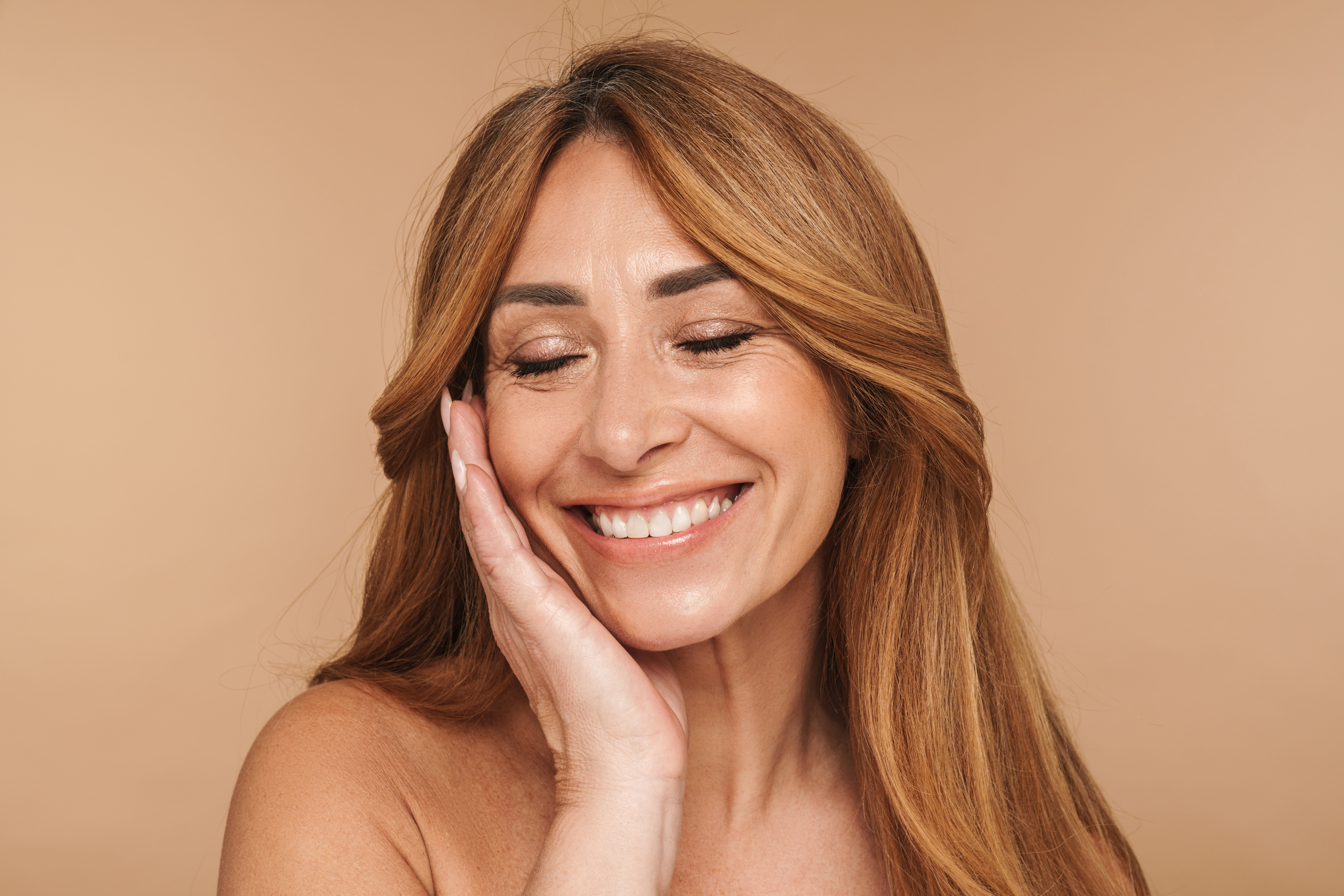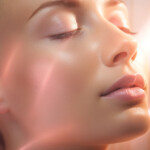Jowls are the sagging or drooping skin that hangs below the jawline and chin area.
More specifically, jowls refer to the loose, hanging flesh along the jawline that creates a pouch-like appearance under the chin and lower face.
They are caused by a combination of factors including:
- Loss of skin elasticity and fat volume as we age
- Gravity causing the skin and fat to sag downwards over time
- Weight fluctuations and weight gain adding excess fat under the chin
- Genetic factors influencing muscle tone and skin laxity
Jowls become more pronounced as the cheek area loses volume and fullness, while excess skin and fat collects below the jaw. This creates a sagging, draped look along the jawline instead of a taut, defined jaw angle.
Jowls and lower-face sagging can be caused or exacerbated by:
Ageing
The natural ageing process causes jowls to form through several interrelated processes:
Loss of Skin Elasticity. As we get older, our skin produces less collagen and elastin – the proteins that give skin its firmness and elasticity. This leads to sagging and loosening of the skin, allowing it to droop downwards along the jawline due to gravity and loss of tautness.
Decreased Fat Volume. The fat pads in the face, especially in the cheek area, begin to diminish and lose volume as we age. This leads to a deflated, hollow look under the eyes and cheeks, causing excess skin to sag downwards into jowls.
Muscle Atrophy. The muscles along the jawline and neck gradually weaken and atrophy with age. This muscle laxity leads to less structural support for the overlying skin, allowing it to sag into jowls.
Bone Loss. Over time, the underlying bone structure in the face can lose density and volume. This reduces the scaffolding that the soft tissues sit upon, permitting skin and fat to descend into jowls.
Gravity. The constant downward pull of gravity becomes increasingly apparent as the supportive structures in the face deteriorate with age. This allows everything from the cheeks down to succumb to sagging, thus forming jowls.
Sun Exposure. Years of unprotected UV exposure accelerates the breakdown of collagen and elastin in the skin through free radical damage, prematurely aging the skin.
Loss of facial volume, bone, fat, muscle tone and skin elasticity that naturally occurs with aging sets the stage for jowls by robbing the lower face of its supportive structures and youthful firmness.
Genetics
Genetics can play a significant role in the development of jowls through a few different mechanisms:
Structure and bone density. The underlying bone structure of the face is largely determined by genetics. People with smaller, more delicate bone structures may be more prone to developing jowls as they age because there is less bony support for the overlying soft tissues. Those with denser, more robust facial bones tend to maintain definition longer.
Skin elasticity. Genetics influence the quality and elasticity of a person’s skin. Some individuals simply produce more collagen and elastin in their skin throughout life, helping the skin retain its firmness and resist sagging into jowls for longer periods.
Fat distribution. Where fat naturally accumulates and diminishes in the face is largely predetermined by genetics. Those whose genes cause them to store more fat in the lower face/chin area are more susceptible to jowling, while others may lose fat preferentially in the cheeks first leading to hollowing.
Muscle tone. This, along with the rate of muscle atrophy or loss as we age, can be impacted by genetics. Better muscle tone helps retain definition, while rapid muscle laxity in the jaw/neck area contributes to jowl formation.
Ageing process. Genetics play a role in how quickly or slowly the overall ageing process unfolds for an individual. Accelerated ageing due to genetic factors can hasten the development of the volume loss, skin laxity and soft tissue descent that leads to jowls.
The genes you inherit can pre-dispose you to having stronger or weaker bone structure, skin elasticity, fat distribution patterns, muscle quality and aging trajectory – all of which influence your likelihood of developing prominent jowls over time. Some simply have a genetic makeup that better delays or prevents jowling.
Smoking
Smoking nicotine products – whether that’s cigarettes or vapes – degrades skin integrity and accelerate ageing, contributing to sagging skin and the consequent development of jowls. Here’s how it happens:
Damages collagen and elastin. Smoke or vapour from cigarettes or vapes contain numerous toxic chemicals and free radicals that damage and break down collagen and elastin in the skin. Collagen and elastin are the proteins that give skin its strength, firmness, and elasticity. As these degrade, the skin loses its tightness and ability to retain its shape, leading to sagging.
Oxygen and nutrient supply. Smoking impairs blood circulation by constricting blood vessels and decreasing oxygen supply to tissues, including the skin. This deprives the skin of vital nutrients and oxygen needed to stay healthy, elastic, and regenerate collagen effectively.
Oxidative stress. The oxidants in cigarette smoke accelerate the oxidation process in the skin, generating free radicals that damage cells and connective tissues. This oxidative stress degrades collagen and elastin proteins prematurely.
Inhibits wound healing. Smoking slows down the skin’s ability to repair itself by inhibiting wound healing and cell renewal processes. This accelerates extrinsic skin aging effects like wrinkles and sagging.
Muscle deterioration. Smoking may contribute to the breakdown of facial muscles due to reduced oxygenation and impaired circulation. Loss of muscle tone allows the overlying skin to sag into jowls.
Dehydration. Compounds in cigarettes have a diuretic effect, depleting moisture and hydration levels in the skin over time. Dry, dehydrated skin is less plump and more prone to sagging.
Weight Fluctuation
Fluctuations in your weight can have a direct impact on your skin’s laxity, and consequently, the occurrence of jowls or sagging skin.
Weight gain and weight loss can both contribute to the formation of jowls, through different mechanisms.
Weight Gain and Jowls:
- Increased fat accumulation under the chin and jawline creates fullness and sagging skin in this area, leading to a ‘double chin’ appearance.
- As fat deposits increase, the extra volume and weight cause the skin to stretch and become looser over time.
- Excess fat in the face can push down on surrounding tissues, creating a dragging effect that promotes jowl formation.
- Rapid or significant weight gain doesn’t allow the skin time to adjust and maintain its elasticity.
Weight Loss and Jowls:
- Losing a substantial amount of weight, especially when older, can leave behind loose, sagging skin that has been stretched out.
- When fat diminishes from the face and cheeks, it can create a hollow, deflated look that causes jowls to become more pronounced.
- The loss of underlying volume and support from fat pads allows facial tissues and muscles to descend downwards into jowls.
- Extreme weight fluctuations of gaining and losing repeatedly can eventually break down the skin’s elasticity irreversibly.
- As we age, the skin loses elasticity, so weight loss later in life frequently unmasks existing jowls.
Weight gain stretches out the skin and adds volume that promotes jowling, while losing weight removes the plumpness and support that previously filled out the jowl area.
Maintaining a stable weight and preserving your skin’s elasticity will help to minimise jowl formation over time.
Sun Damage
Sun exposure and UV radiation can contribute to the development of jowls through several mechanisms.
Breakdown of collagen and elastin. UV rays generate free radicals that damage and degrade collagen and elastin – the proteins that give skin its firmness and elasticity. With repeated UV exposure, these structural proteins break down, and the skin loses its ability to expand and contract. This impairs the skin’s resiliency and elasticity along the jawline, leading to lax skin forming jowls.
Accelerated skin ageing. Sun damage causes premature aging of the skin by generating oxidative stress and inflammation. This speeds up the breakdown of collagen and thinning of the dermis over time, leaving skin more prone to wrinkles, discoloration, and loss of tightness that can manifest as jowling.
Dehydration and volume loss. UV exposure can deplete the skin’s moisture levels and break down hyaluronic acid that gives skin its plumpness. Dehydrated, thin skin is more likely to sag and crease into jowl lines.
Facial muscle damage. There is some evidence that UV rays can contribute to disorganisation and deterioration of the fibrous connective tissues attaching facial muscles, leading to loss of structural support.
Loss of fat pads. For some, cumulative UV exposure may accelerate the breakdown and deflation of the fat pads in the cheeks. Without this natural volume providing structure and support to the lower face, skin may slacken to form jowling.

























 Face + Neck
Face + Neck  Body
Body  Laser
Laser  Skin
Skin  Concerns
Concerns